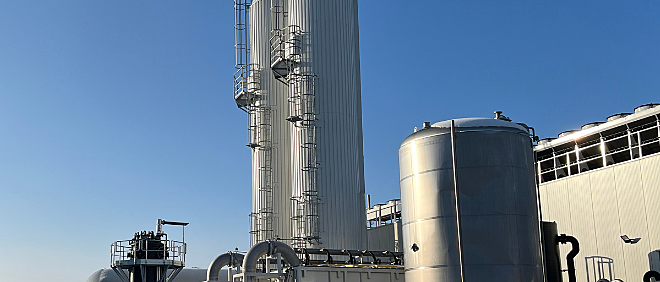Upflow Anaerobic Sludge Blanket - BIOTIM® UASB Reactor
Explore how BIOTIM UASB technology is transforming wastewater treatment in the food & beverage industry, leading the way towards a more sustainable future.

What is an Upflow Anaerobic Sludge Blanket?
An Upflow Anaerobic Sludge Blanket (UASB) reactor is a type of wastewater treatment process that utilizes anaerobic microorganisms to break down organic pollutants. The UASB reactor is a cost-effective, energy-efficient solution for treating high-strength organic wastewater, converting pollutants into biogas while producing minimal sludge. Its compact design and ability to handle high organic loads make it a preferred choice for various industrial applications.
A Leap Towards Sustainability in the Food & Beverage Industry: BIOTIM UASB
In an era where sustainability is not just a goal but a necessity, the food and beverage industry is under increasing pressure to adopt eco-friendly practices, particularly in wastewater management. Waterleau's BIOTIM UASB (Upflow Anaerobic Sludge Blanket) technology emerges as a groundbreaking solution, offering not just treatment of bio-effluent but also remarkable energy recovery and significant reduction in CO2 footprint.
As the market leader in anaerobic wastewater treatment within the food & beverage sector, Waterleau stands at the forefront with an enviable track record in the brewery, potato, and dairy industries, showcasing its unparalleled expertise and commitment to environmental excellence.
How does the UASB reactor work? The process explained
Influent wastewater introduction
At the heart of BIOTIM UASB technology lies an advanced anaerobic treatment method that transforms organic pollutants in wastewater into biogas—a clean, renewable energy source. This process begins with the influent wastewater being fed from the bottom of the reactor through the inlet distribution system.
Upflow movement
The wastewater flows upwards through a dense bed of granular sludge at the bottom of the reactor.
Anaerobic digestion
Anaerobic bacteria within the sludge blanket break down organic pollutants in the wastewater.This process produces biogas, primarily composed of methane (CH₄) and carbon dioxide (CO₂).
Biogas production
The biogas rises to the top of the reactor and is collected in a gas collection system.Special devices, called gas-liquid-solid separators, help separate the biogas from the treated water and sludge.
Effluent discharge
Treated wastewater exits from the top of the reactor, typically passing through a settler to remove any remaining suspended solids.
Sludge retention
The sludge that accumulates at the bottom of the reactor is periodically removed and can be further processed or used as a soil conditioner.
The Role of BIOTIM Scrubber in Enhancing Biogas Quality
A key component in maximizing the biogas utility from the BIOTIM UASB process is the BIOTIM Scrubber. This cutting-edge solution for biogas desulfurization efficiently extracts hydrogen sulfide (H2S) and other sulfur compounds from biogas, safeguarding cogeneration equipment from corrosion and ensuring the biogas meets energy use standards. Incorporating the BIOTIM Scrubber elevates the sustainability and economic value of the generated biogas, positioning it as a cleaner, more adaptable fuel alternative.

Advantages of the UASB reactor
Energy Recovery and Renewable Energy Utilization
The conversion of organic waste into biogas through the BIOTIM UASB process underscores a significant leap in energy recovery. This not only provides a renewable energy source capable of powering facilities but also curtails energy expenses and lessens reliance on fossil fuels.
Significant Reduction in CO2 Footprint
By generating renewable energy and reducing the need for energy-intensive aeration in aerobic processes, the BIOTIM UASB technology markedly diminishes greenhouse gas emissions, contributing to a leaner carbon footprint.
Cost-Effectiveness and Operational Efficiency
The anaerobic process heralded by BIOTIM UASB emerges as more economical over time, showcasing lower operational and maintenance costs in comparison to conventional aerobic treatment systems. Its efficacy in managing high-strength wastewater renders it particularly apt for sectors known for bio-rich effluent, such as breweries, potatoes, and dairy, bolstering its status as a superior choice for the food & beverage industry.
BIOTIM UASB's impact on the food & beverage industry
Waterleau's leadership in anaerobic wastewater treatment is supported by a robust portfolio of successful implementations across the food & beverage industry's various sub-sectors. These success stories not only attest to our proficiency and dedication to environmental stewardship but also invite industry leaders and environmental managers to explore the BIOTIM UASB technology.
By adopting this innovative technology, businesses can make strides in their sustainability objectives, transforming their wastewater management practices, enhancing energy recovery efforts, and contributing to a healthier planet.
A Call to Action for a Sustainable Future
We invite industry leaders and environmental managers in the food & beverage sector to explore the benefits of the BIOTIM UASB technology. Whether you are interested in understanding the technology, discovering its advantages, or examining our extensive list of references, Waterleau is here to guide you towards achieving your sustainability objectives.
For more information on how BIOTIM UASB technology can transform your wastewater management practices, enhance your energy recovery efforts, and contribute to a greener planet, contact Waterleau today. Together, we can embark on a journey towards a more sustainable and environmentally responsible future.
Our BIOTIM UASB technology cases

Sustainable sugar refining near Paris, France

Sustainable Brewing in Colombia: How Waterleau's BIOTIM® UASB Transforms Central Cervecera
The CCC Brewery treats different wastewater & waste streams before safe discharge to the open water bodies.
Frequently asked questions on BIOTIM UASB Technology
How does BIOTIM UASB technology contribute to sustainability?
BIOTIM UASB technology contributes to sustainability through its efficient wastewater treatment process that not only purifies water but also generates renewable energy in the form of biogas. This approach significantly reduces the CO2 footprint by minimizing the need for energy-intensive aeration processes typical of aerobic systems. By converting organic waste into biogas, a clean energy source, it supports the transition from fossil fuels to renewable energy, aligning with global sustainability goals and promoting a circular economy in the food & beverage industry.
Can BIOTIM UASB handle high-strength wastewater from all food & beverage sectors?
Yes, BIOTIM UASB is specifically designed to manage high-strength wastewater characteristic of various sub-sectors within the food & beverage industry, including breweries, dairies, and potato processing plants. Its effectiveness lies in the technology's ability to treat bio-rich effluent, efficiently breaking down organic pollutants into biogas, thus making it suitable for a wide range of applications within the industry.
What makes BIOTIM Scrubber essential in the BIOTIM UASB process?
The BIOTIM Scrubber plays a crucial role in the BIOTIM UASB process by enhancing the quality of the biogas produced. It does so through the desulfurization process, removing hydrogen sulfide (H2S) and other sulfur compounds from biogas. This step is essential for preventing corrosion in cogeneration equipment and ensuring the biogas meets quality standards for energy use. The scrubber effectively increases the economic value of the biogas, making it a cleaner and more versatile fuel option.
How does the energy recovery aspect of BIOTIM UASB work?
The energy recovery aspect of BIOTIM UASB works by transforming the organic pollutants in wastewater into biogas, a renewable energy source. This process occurs in the anaerobic treatment where dense anaerobic bacteria digest organic matter within the wastewater, producing biogas. This biogas can then be captured and used to generate electricity or heat, reducing energy costs and dependence on non-renewable energy sources, thus contributing to the sustainability goals of the food & beverage industry.
What are the cost benefits of switching to BIOTIM UASB technology?
Switching to BIOTIM UASB technology offers several cost benefits, including reduced energy consumption, lower operational and maintenance costs compared to aerobic treatment systems, and the generation of biogas, which can be used as a renewable energy source to power facilities. These factors contribute to significant savings over time, making BIOTIM UASB an economically viable option for businesses seeking to improve their wastewater management systems while also reducing their environmental impact.
How can businesses start implementing BIOTIM UASB technology?
Businesses interested in implementing BIOTIM UASB technology should begin by conducting a thorough assessment of their current wastewater treatment systems and sustainability goals. Contacting a specialist like Waterleau, the provider of BIOTIM UASB technology, is a crucial next step. Waterleau can offer expert guidance on the integration process, tailored to meet the specific needs and capacities of the business. This may include feasibility studies, design and engineering services, installation, and operational support to ensure a smooth transition to a more sustainable and efficient wastewater treatment solution.
What are the disadvantages of a UASB?
How to maintain a UASB reactor?
Find your local contact
Our expertise is always within reach. Digital communication has cut long distances short, but we advocate the traditional way of sharing insights.
Contact us today. We are looking forward to help you reach your sustainable development goals.




